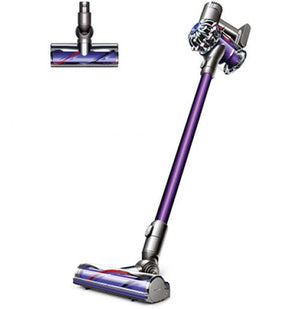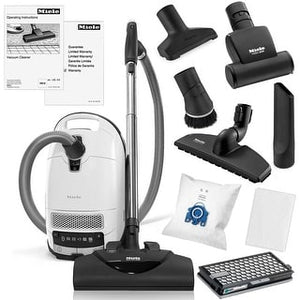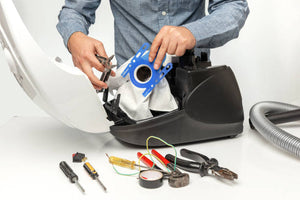How To Keep My Vacuum Cleaner Efficient And Long-Lasting?

How often do you think about your vacuum cleaner while you’re so busy in your daily life? Your answer is probably “Not too often…”When cleaning your home, you want your vacuum cleaner to be easy to use, to pick up all the stubborn dirt and make your job easier, faster and more effective. I hear this all the time from my customers! That’s why I believe this topic is worth discussing regarding the frequency a vacuum cleaner should be maintained so that it lasts a very long time and is always working at its best. Like any other machinery (a car, a sewing machine, etc.) a vacuum cleaner needs some maintenance, too.
You will be surprised to know that an average American household spends approximately $262 every two years on buying a new vacuum cleaner. Most people choose the cheapest vacuums from big box stores and sometimes they end up purchasing three low-quality vacuums within only two years. How crazy is that? Shouldn’t a vacuum cleaner last longer than that if I may ask? I will talk about choosing the right vacuum for your needs in my next blog, but today I want to talk about some easy, non-expensive solutions, which will prolong the life of your current vacuum(s).
Before making a do’s and don’ts checklist, let me tell you what makes a vacuum cleaner effective for cleaning your home. In order to have a vacuum pick up the deep ground-in, stubborn dirt, here are a few things you need to make sure that your vacuum has before using it:
- Good suction power
- Good agitation
- Good airflow
These three factors will help you use your vacuum cleaner the right way.
Good suction power is important for deep dirt pick-up, and most vacuums will have a good suction power when they are new, regardless of their price. They lose suction over time and here is what you need to do to keep the suction power at its highest level:
- If your vacuum is bag less, make sure you wash the dustbin each time you finish vacuuming. Since all the dust and dirt is collected in the bin, the pores that pull the dirt in will sooner or later get clogged and in turn it will result in loss of suction power.
- Every vacuum cleaner regardless of bag or bagless, upright or canister, has two main filters. The first one is called pre-motor filter, which protects the motor from dust getting into the motor parts. The second one is called post-motor filter, also called HEPA filter which captures the dirt and prevents it from getting out of your vacuum into the air you breathe. This filter provides you with a high filtration. In order to get a good suction power and maintain good airflow, make sure your pre-motor filter is not clogged. A good majority of pre-motor filters are made of foam and are washable. It is recommended to wash the pre-motor filter and dust bin after you’re done with vacuuming but make sure you dry them completely before using them again.
- In the case of a bagged vacuum, check the bag before vacuuming. If it is more than 2/3 filled to the top, it’s about time to insert a new vacuum bag for better suction power and to avoid overfilling it and expelling dust back into the air that you and your family breathe.
Good agitation is another important factor for an effective carpet cleaning. Most vacuums get their agitation through a belt which is driven by the motor shaft and in turn the belt spins the roller brush. The belt provides the roller brush with good agitation so that it can pull the dirt from inside the carpet fibers into the vacuum while cleaning. Here are some tips to check for your vacuum’s agitation:
- Before you start vacuuming the carpet(s), check the roller brush and see if it is spinning while the vacuum is on.
- If it is not spinning, check if the vacuum is on the correct mode. If you’re cleaning carpets switch the vacuum to the carpet mode if you didn’t do so yet. Having your vacuum on bare floor mode will obviously not going to clean carpets.
- If everything above looks good but you’re still having problems with your vacuum, try to rotate the roller brush manually and observe if it is loose or tight. When a belt breaks, the roller brush will rotate easily while spinning it manually. To prevent all this unnecessary hassle, change the belts on your vacuum cleaner every 6-12 month's even when the vacuum is not defective. The time between changing belts depends on how often you use your vacuum. The flat belts stretch out over time and they will affect the spinning speed of the roller brush, thus affecting the total agitation of your vacuum.
- Another thing to keep in mind regarding the agitation is having your roller brush clean. Check your roller brush each time you finish vacuuming and make sure that it is hair and threads free (unless you like the Rapunzel look on your roller brush). Yes, I said it because I’ve seen it many times. The amount of hair and threads on the roller brush will wear off the belts and break them before you know it.

Good airflow is as important for an efficient cleaning as it is for your lungs. Here are a few things you have to look for:
- The post-motor filter is crucial for a good filtration. It is not only protecting your lungs by capturing the dirt and allergen particles coming out of the vacuum, but it also maintains a good airflow. Check the post-motor filter every 6-12 months and if it looks dark and clogged then it’s the right time to change it. Most people ignore this issue and they end up overheating and burning the motor.
- Most of the post-motor or exhaust filters are made of compressed paper and these are not washable. Washing them will only eliminate the odor, not the clogged pores. Bottom line – do not wash paper filters. Throw them away and replace them with new ones.
Let’s review and check these tips to see if you’re treating your vacuum cleaner the right way:
- Change belts every 6-12 months even if they are not broken. A belt will cost you between$3-$6
- Clean the roller brush after every use to avoid belt overstretching or even melting the end caps of the roller brush which in turn will result in additional expenses
- Change the post-motor and pre-motor filters every6-12 months for a better filtration
- Change the vacuum bag when is 2/3 full. In case of a bagless vacuum - wash the dust bin each time after use and dry it completely before the next use.
- Never ever, ever vacuum drywall particles, any liquid or semi-liquid dirt. This will only damage the motor and again dollar signs everywhere. Use a Shop-Vac instead, which is perfect for this type of cleaning, not a regular vacuum cleaner.
Thank you for reading my blog. I hope I covered the main issues that almost everyone has with their existent vacuum(s). I will later on post another blog about how to choose the right vacuum for your cleaning needs. Keep reading my updates and if you have any questions, please post your comments below.
- Tags: RED Vacuums Store vacuum cleaner repair Vacuum Cord Repair Vacuum Parts Brands Vacuum Repair Vacuum Repair Baltimore Vacuum Repair Columbia Vacuum Repair Ellicott City Vacuum Repair Fairfax Vacuum Repair Falls Church Vacuum Repair Frederick Vacuum Repair Glen Burnie Vacuum Repair Rockville Vacuum Repair Service Vacuum Repair Services Vacuum Repair Services Vienna Vacuum Repair Shop Vacuum Repair Shop Vienna Vacuum Repair Shops Vacuum Repair Store
- Admin .







Comments 0